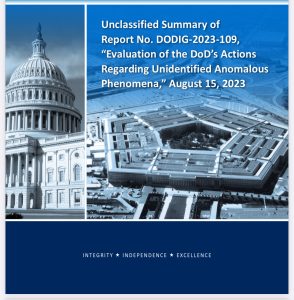
A report issued last fall by the Department of Defense has found that the DoD appears to have not “developed a comprehensive and coordinated strategy for understanding, identifying, and protecting against unidentified phenomena that may present a safety threat to military personnel and territory,” despite such responsibilities being mandated by law under the National Defense Authorization Act. In 2022 the DoD established the All-domain Anomaly Resolution Office to accomplish this cross-agency coordination, but according to the report AARO and DoD have yet to provide an overarching UAP reporting and investigative framework that encompasses all branches of the military and intelligence services.
On January 24 an unclassified summary of a report released in August 2023 titled ‘Evaluation of the DoD’s Actions Regarding Unidentified Anomalous Phenomena’ was released by the Department of Defense Office of Inspector General (DoD OIG), evaluating the DoD’s response to the issue of UAP posing a potential national security threat to the United States.
The report states that despite the various departments and agencies operating under the DoD having “developed varying processes to collect, analyze, and identify UAP incidents” the Department itself has “not used a coordinated approach to detect, report, collect, analyze, and identify UAP.” Further, the individual DoD Components “have largely excluded geographic combatant commands” from their efforts, meaning many UAP encounters being experienced by overseas military personnel are not being centrally collected, investigated or analyzed.
The report states that the DoD “has not issued a comprehensive UAP response plan that identifies roles, responsibilities, requirements, and coordination procedures for detecting, reporting, collecting, analyzing, and identifying UAP incidents,” resulting in the response to UAP incidents being “uncoordinated” and instead are “concentrated within each Military Department.”
This lack of guidance from the DoD has left each of the Department’s agencies to individually develop “varying informal processes to detect and report UAP incidents,” typically adapted from systems already in place.
As an example, the Air Force designates UAP “as a ’Special Interest Item’ which requires aircrews to document and report UAP observations within 24 hours of engine shutdown and mission completion” through the Marauder mission reporting system, according to an Air Force Remotely Piloted Aircraft and Airborne Intelligence, Surveillance, and Reconnaissance Technical Advisor that was interviewed by the DoD OIG; according to an Army Senior Advisor the same system is used by Army personnel to report UAP sightings, “because the Army has not developed its own UAP-specific processes.”
The report concludes that “the DoD’s lack of a comprehensive, coordinated approach to address UAP may pose a threat to military forces and U.S. national security.”
“We determined that the DoD has no overarching UAP policy and, as a result, it lacks assurance that national security and flight safety threats to the United States from UAP have been identified and mitigated,”
The report offers five recommendations to rectify the issue, chiefly that the Under Secretary of Defense for Intelligence and Security, in coordination with AARO’s Office Director, issue a new DoD policy designed to integrate the various “roles, responsibilities, requirements, and coordination procedures” across the DoD’s agencies and departments “into existing intelligence, counterintelligence, and force protection policies and procedures.”
Until the DoD is able to draft these overarching policies, the report recommends that the Air Force, Army and Navy each issue their own “interim guidance” for dealing with UAP. Additionally, it recommends that the Chairman of the Joint Chiefs of Staff issue similar interim UAP guidance to the individual geographic combatant commands, and that these interim policies should at the very least “include tools to help commands determine the threats posed by unidentified anomalous phenomena.”
Subscribers, to watch the subscriber version of the video, first log in then click on Dreamland Subscriber-Only Video Podcast link.
Is there intelligent life on this planet?